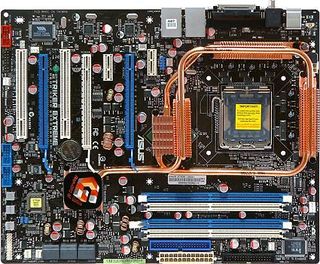More Than Just a 'Paper Launch': 680i Motherboard Comparison, Part 1
Asus Striker Extreme
Asus was the only company to introduce a uniquely designed board within the first month of 680i production. First isn't always best, but Asus believes its Striker Extreme will put these worries - and competing products - to rest.
Feature Overview
The first thing that stands out about the Striker Extreme is the extreme Chipset/VRM cooling apparatus. These components probably weigh more than the rest of the board, using a complicated multi-piece Northbridge sink and four heat pipes. Also standing out is the striking blue and white slot color combo in stark contrast to the black circuit board.

As per 680i specification, the two blue PCI-Express x16 slots provide the full 16 pathways to each card for top SLI performance, while the white x16 slot makes due with only eight. Asus provides only three low-bandwidth expansion slots, two PCI and one PCI-Express x1, reserving the topmost slot position for its custom audio riser card.
Asus puts its ATX and ATX12V connectors front and top to ease cable management, but also puts the floppy connector in a convenient upper-front edge location for anyone who needs it. The Ultra ATA connector is also located in what would have been an ideal location for routing its cable to upper drive bays, but routing the drive cable around the ATX power cable proves challenging. We'd have preferred the ATX and floppy connector positions to be reversed to ease Ultra ATA cable management, if such a design were feasible.
All six Serial ATA connections are parallel to the board's surface, allowing them to slip under the extended end of long graphics cards in x16 slots two and three, but this orientation may cause the connectors to be blocked by the lower drive cage of some cases. And while most of the remaining layout is great, the IEEE-1394 connector is in the lower-rear corner, far away from most front-panel FireWire ports.
The last bit of convenience is a group of lighted switches along the forward bottom edge, including Power, Reset and Clear CMOS. These will be most useful for bench testing, and the Clear CMOS switch must be enabled by jumper before becoming effective.
| Asus Striker Extreme (Revision 1.00G) | |
|---|---|
| Northbridge | Nvidia 680i SLI (C55XE) |
| Southbridge | MCP55XE |
| Voltage Regulator | Eight Phases |
| BIOS | 0402 (11/10/2006) |
| 266.6 MHz (FSB1066) | 266.6 MHz (+0.0%) |
| Connectors and Interfaces | |
| Onboard | 3x PCIe x16 (1 with x8 pathways)1x PCIe x12x PCI1x Audio Riser Slot3x USB 2.0 (2 ports per connector)1x IEEE-1394 FireWire1x Floppy1x IDE6x SATA 3.0Gb/s1x Chassis Intrusion Connector1x S/P-DIF Out1x Fan 4 pins (CPU)7x Fan 3 pins (System)3x Thermal Sensor Connector1x Power Button1x Reset Button1x Clear CMOS Button |
| IO panel | 2x PS2 (keyboard + mouse)2x Network4x USB 2.02x eSATA1x IEEE-1394 FireWire2x Digital Audio In (optical + coaxial)1x Power Button1x LCD POST Display |
| Mass Storage Controllers | |
| MCP55XE | 6x SATA 3.0Gb/s (RAID 0,1,5,10)1x Ultra ATA-133 (2-drives) |
| Silicon Image SIL3132 | 2x External SATA |
| Network | |
| Dual NVIDIA Gigabit Network | 2x Marvell 88E1118-MNC1 PHY |
| Audio | |
| HDA (Azalia) Controller Interface | ADI 1988B 7.1 Codec on Riser Card |
| FireWire | |
| VIA VT6308P | 2x IEEE-1394a (400 Mb/s) |
No release date was given for Striker BIOS 0402, so we were forced to use its compilation date. Previous version 0302 had a release date of 11/21/2006.
Stay on the Cutting Edge
Join the experts who read Tom's Hardware for the inside track on enthusiast PC tech news — and have for over 25 years. We'll send breaking news and in-depth reviews of CPUs, GPUs, AI, maker hardware and more straight to your inbox.
What's missing from the back panel? Analog audio functions are handled by a riser card to reduce signal noise, and what remains are digital optical and digital coaxial outputs. Asus puts both Silicon Image SIL3132 connections on External SATA out back, as well as one of its two VT6308P IEEE-1394 FireWire 400 ports.

Asus adds a diagnostics display where other boards have empty space (or previously had a parallel port) and also adds yet another lighted power switch. Other empty space can be found on the left side of the panel, as Asus has shifted its PS/2 connectors approximately one-half inch to the right. This strikes us as odd, since Asus has formerly used left-over space on the left-hand side to mount a USB wireless card, and included a USB connector in the appropriate location.
Most Popular


